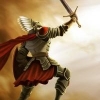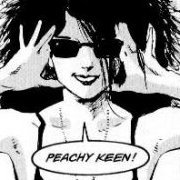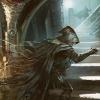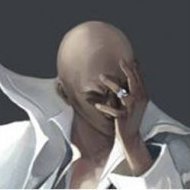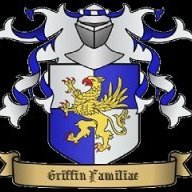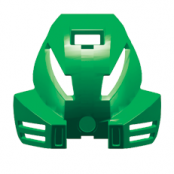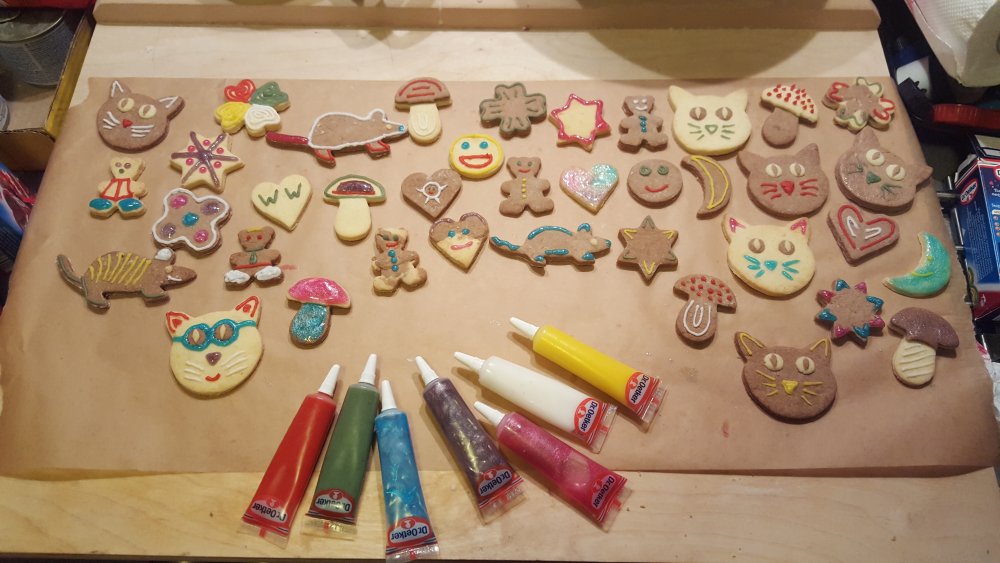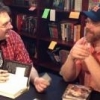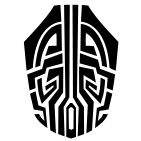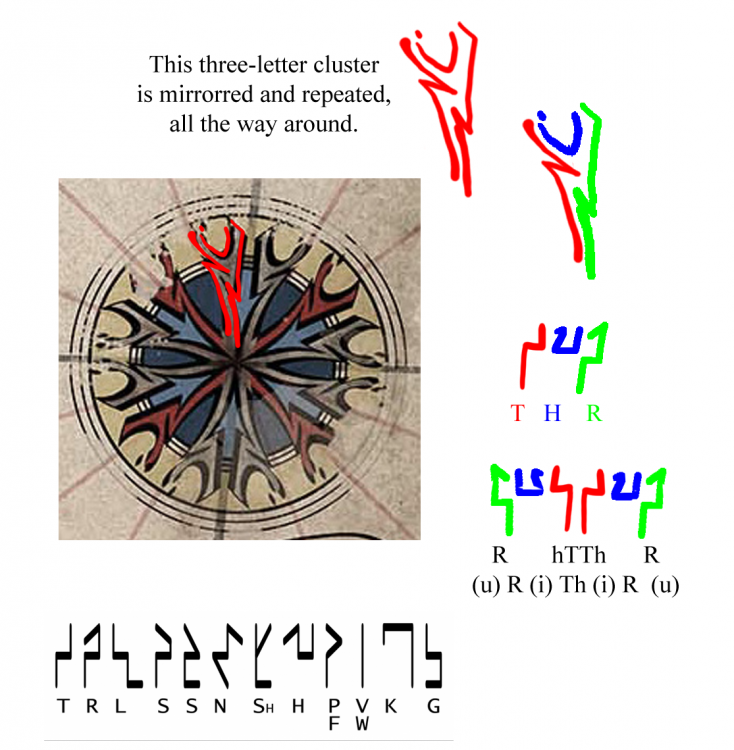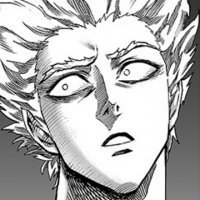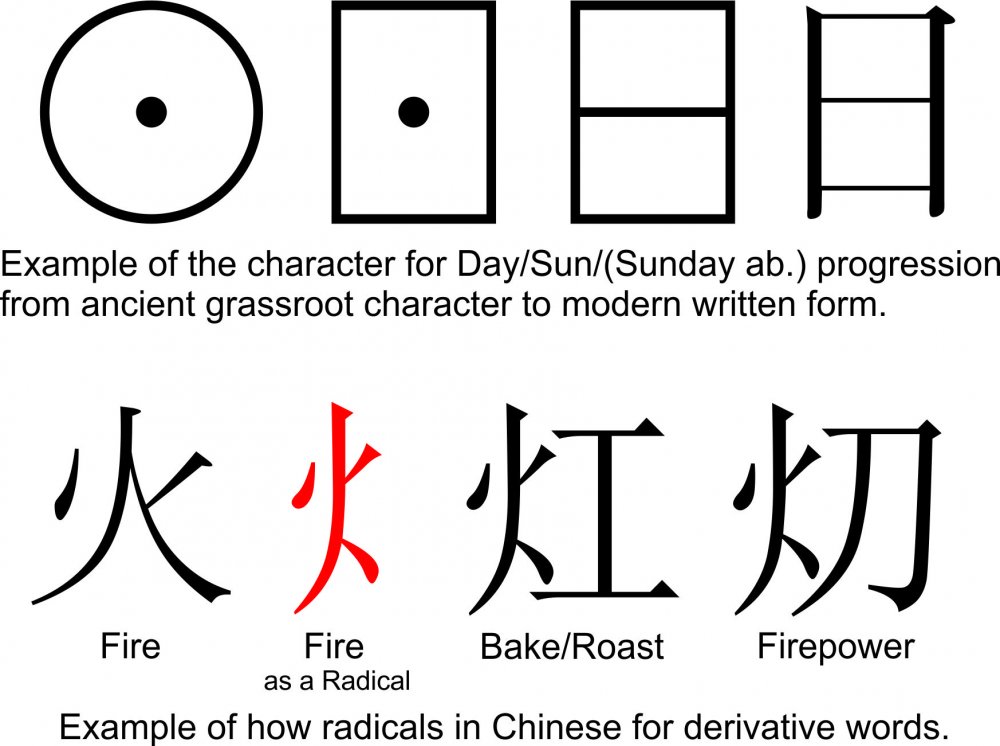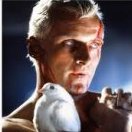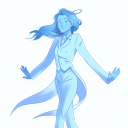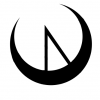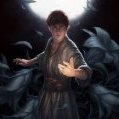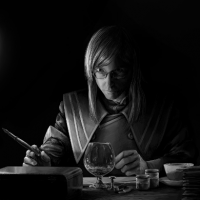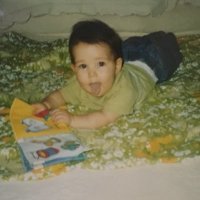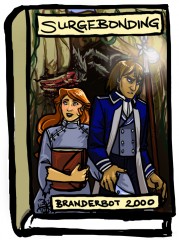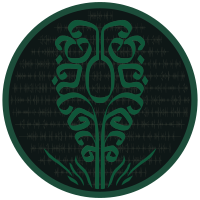Leaderboard
Popular Content
Showing most liked content on 12/30/16 in all areas
-
Don't know if this is the place to post this, but I asked a few questions. Me: Other than vessels, how many beings have lived from before the Shattering until the time of the Way of Kings? Brandon: More than you would think. Longevity is not hard to come by in the Cosmere. That much longevity would be a little uncommon. But certain species are particularly long lived, and certain magic systems enable longevity. Me: Did Odium splinter all the shards for the same reason? Brandon: No. Some shards he splintered because he feared the shard itself, and some shards he targeted because he feared the vessel. He was working his way down his list in order of the shards and vessels he felt would be most dangerous to his plans until he got stuck on Roshar.15 likes
-
LG29: Day Four - Uninhibited Chaos Kelen Taldar was happy today. He knew exactly why, too, unlike a number of poor souls in the Cosmere. He had a Cause. In fact, he was Devoted to a Cause. Hunting down the Wanderer was an important mission, one that he was not going to leave in the hands of just anybody. After all, who better than himself to do it. Whistling, he walked along a path on Scadrial. He liked this form. It gave him a sense of...fitting in. He didn’t always have that. The sudden pain caught him by surprise. The shattering of his Shard was an even bigger surprise. But the darkness that yawned up at him, spreading from the feet of a hateful, towering figure - that surprised him most of all. As his mind passed into the Great Beyond, he heard a chuckling voice. “Foolish mortal, to think that I was safely bound, protected from my own hate. Foolish indeed.” Across the Cosmere, chaos reigned. A second Shard had been Shattered, and panic was overcoming everyone. On a small island on Roshar, Stormlight flared once, and the worlhopper known only as the PUNisher fell, gasping for air. Near the shattered remains of Preservation’s Garden, the mind of Farallen Ortiz looked towards the light, and was gone. And in a shadowed room overlooking a back alley in Scadrial, Jack Tormander saw - in an instant - the moment he had been Returned for. Facing his friends across the small desk, he stood, then whispered. “My life to yours. My Breath become yours.” His body stiffened, falling backwards. The glass window behind him cracked, then broke open beneath the weight of his falling body. His last words hung in the air behind him. “Libertas Regnabit!” Jack Tormander (A Joe in the Bush) has passed to the Spiritual Realm. He was a Returned Agent of Autonomy! Farallen Ortiz (Conquestor) has passed to the Spiritual Realm. He was a Vessel of Preservation! AliasSheep (AliasSheep) has been killed! His role and alignment will be revealed when he passes from the Cognitive Realm. PUNisher (harambe) has been killed! His role and alignment will be revealed when he passes from the Cognitive Realm. Devotion has been Shattered! Day 4 has begun, and will end in 46 hours. Due to time conflicts, Day 4 will be ending 2 hours early! I apologize for any inconvenience this may cause. Future cycles will return to turnover at 2:00 PM, Mountain Time Player List: 1. Assassin in Burgundy - First of the Game 2. Master Elodin - Second of the Signups 3. Jondesu - Quintus 17th Shard 4. AliasSheep - Kelen Taldar 5. Darkness Ascendant - Kaldain Selblessed 6. A Joe in the Bush - Jack Tormander Returned Agent of Autonomy! 7. Doc12 - Silence 8. Kynedath - Desten Kyde 9. TheMightyLopen - Kaloo 10. Straw - Malum Farcimen 11. Young Bard - Serol 12. Magestar - Magestar 13. Alvron - Lorna 14. Dalinar Kholin - Sanya 15. Harambe - PUNisher 16. I_am_a_Stick - Stic 17. RubiksCube - cubefright archive 18. DroughtBringer - Ralar 19. Araris Valerian - Aralis 20. Arinian - Arinian 21. Zephrer - Tardeick 22. Conquestor - Farallen Oniz Vessel of Preservation! 23. Sart - Sam Trudite 24. Aonar Faileas - Nilan Izenry 25. Elenion - emissary of Mandos 26. Kasimir - Tenth of the Dusk7 likes
-
I finished the first draft of a thing! It's a little over 2000 words, third person, past tense. It needs an edit, but I am proud of it. Un, it is pretty much what would have happened if Clive Barker had decided to rewrite Little Red Riding Hood... in fact my pitch to myself was "New Murders in the Rue Morgue+Little Red Riding Hood"... It gets weeeeeeird, but i like it.6 likes
-
From the album: Stormlight drawings
Just a photoshop drawing of what Roshar might look like from orbit with a Hightstorm arriving in the eastern edge of the continent.5 likes -
Night 9: Liar When Arinian woke up in the morning, he found half a dozen people all looking down at him. Before he could even voice his defence, not that he would say he had any, he felt something hempen being draped around his neck and then tightened. Arinian was a Forger with a Vial of Pewter and a Vial of Copper! Arinian (6): Dr Konwa Arelle (Wonko the Sane), Shara (Nyali), Aralis (Araris Valerian), Exion (Unodus), Sheon Idris (Seonid), Kresla (Elbereth) Character List Kasther's Pocketwatch5 likes
-
Aman would be proud of this wall of text. Preservation: Day Objectives: Use investment action on players who could benefit from it. This would be especially effective on Returned, as that allows them to use their mass-protect without dying. Night Objectives: Use Shardic action to preserve players. This ability effectively takes lynching and returning choices away from the village, though, so Pres should hold off on using it unless they have a good reason to suspect that a living player is village or a dead player is an elim. Should it be confirmed that Endowment is with the 17th, Pres should focus on locking down those lynched from Returning. Either: Freezing the round is a two-edged sword: it can stop the lynch from swinging or Odium, Hoid, etc. from putting in their orders, but it also suppresses beneficial actions. If Pres plans on using this, they should notify their trusted players in advance so they can send in their actions before the freeze. Ruin: Day Objectives: The Roleblock can actually be used as a powerful tool to scan for Odium. Ruin should Invest in a single player during the day, and during nights that player should target a bunch of different players. If the Odium kill suddenly doesn't happen, we then have a major suspect, unless Odium just didn't put in a kill in an attempt to misdirect us, but even then Odium loses a kill opportunity. Night Objectives: Kill Harambe! Well, anyone whom the thread is largely-suspicious of. Either: Destroying a world is generally not beneficial for the village, but Elim!Ruin could use this to great effect. However, in a pinch this could be used as an (admittedly heavy-handed) roleblock to Odium or Hoid. Devotion: Day Objectives: Lynch protection is a valuable commodity, so I would advise Devo to use that ability sparingly. The lynch is one of our best tools, and a no-lynch is generally very unhelpful (as we've seen so far). Night Objectives: Communication this game is important, so keep the PMs going. PM groups should be kept small to facilitate role-claiming, and the members of the PMs should be kept constantly-rotating. Do not put yourself in many of your PMs, to avoid suspicion, but put yourself in a few so that your absence isn't noted. Dominion: Day Objectives: Domin's investment is not very powerful, and is beneficial for the village as a whole, so be generous with it. Target especially active voters. Night Objectives: Redirect a variety of players onto themselves. For most Shards, this is not harmful, but if you can get Odium to Shatter himself then it's game over for Team Hate. Domin's force-perform-action isn't nearly as utilitarian as the general redirect, but if it's discovered that the 17th has a specific Shard then Domin can usually put that ability to good use. Endowment: Day Objectives: Endowment's Investment would be made better by moving to a planet with powerful roles (Scadrial is probably the most) and investing in players on that world to ensure that the most powerful abilities hit the field. However, don't stay in one place for too long, or Odium might catch on. I know that sounds contradictory, but do your best. Night Objectives: Returning should only be used on those night-killed by Odium, because a lynch gives us nothing if the lynchee doesn't stay dead. Endowment would be a horrible Shard to have in the hands of the 17th, so don't pass unless absolutely necessary for the Shard's safety. Cultivation: Day Objectives: Vote-manip is usually better for elims than for villagers, so Invest with judgment. However, there are some good uses for manip, like forcibly-solidifying lynches, so Investing is a sort of judgment call for Culty. Night Objectives: Cult's main job is to battle Odium. As long as Cult regenerates a Shard every round, Odium can't win until he Shatters her. For this reason, Cult should be kept in constant motion between a group of people cleared by Dominon's general redirect. Alternate Night Objectives: Cult can also be used to super-charge minor roles. This is doubly-effective on powerful roles that receive 2 items instead of one due to this action, such as Mistborn, Lifeless Commander, and Voidbringer. Lifeless Commander is probably the best of these to choose, but be careful who you trust. Anonymous Investing is recommended. Honor: Day Objectives: Find a champion. I would suggest that Honor changes champions periodically to ensure that Odium's Champion doesn't zero in on them, but a given champion should be good for at least a few cycles. An interesting companion to this ability is that it fails on Shards, so as a last resort it can be used to scan for Shards, although I wouldn't suggest doing that unless the situation is truly desperate. Night Objectives: Protect claimed/suspected Shards. Since Odium is the only one who would want to target Honor specifically, self-protecting is not going to be a good idea. Odium: I Hate you. Autonomy: You're on your own. Survival: Repeatedly invest in Len. TL;DR: My #1 discovery is that Domin's redirect is a terrifyingly-effective way to scan for Odium. Just redirect random active players onto themselves, wait, and laugh when Odium shatters himself.5 likes
-
Elantris Spoilers: SO a bit late with this, and i don't know if this is already accepted as general knowledge, but at the signing i asked about the number of people who died to give Dilaf the power to resist Aon's the text says it took something like 50 (don't have the book with me). I asked if the number of deaths was essential to make Dhakor work or if a single person with say 50+ breaths or a surgebinder with an equivalent amount of stormlight would work. ANSWER: "The amount of investiture is what is important not the number of people." He also said that different types of investiture would work, but turned to sign another book so i missed if there was any caveats on using other types of investiture.5 likes
-
Bzeth frowns, looking down at the torn pieces of a map in his hands that he has come across while scouting ahead. There isn't time to put the pieces together right now to see what the map shows - a highstorm is approaching and he and his companions need shelter - so he tugs them safely into his bag to study later. He stands up and hears a rustling sound behind him. Turning around, he sees a blur. Someone quickly ducking down behind a bush. Tentatively, he walks towards it. Just as he gets near, metal flashes, and a person pounces from behind it, a knife in hand aimed straight at Bezth’s chest. Instincts kick in, and Bezth side-steps the man, spins around while grabbing his twin daggers from his belt, and slices deeply at the back of the man’s knees before he even lands. The man hits the ground and collapses, unable to get back on his feet. Bezth then pushes his dagger through the man’s shoulder, getting a gasp and a raspy curse from him before he falls into unconsciousness. Two bags full of jewels and gemstones and spheres are tied at his waist. What a cremling, Bezth sighs and shakes his head while dragging the robber’s body to leave it behind the bush, then makes his way back toward his companions. Or rather….. An idea occurs to him. He goes back, ties the robber’s hands and legs, gags him, swings him onto his shoulder, turns around and heads back, leaving a trail of blood behind.4 likes
-
The inactivity in the last few games has been absurdly high. It's generally higher than it should be anyway (Luckat, a player who's been around since LG2, quit SE completely in large part due to inactivity), but it's been significantly worse in recent games. I'd rather people not sign up and the game runs with less people but everyone is active, than I get 25+ players, but 10 of them aren't even paying attention. The first run of this game had 36 players, and over 10 of them were inactive. I'm not doing that again. That said, if you only do one on the first cycle but all three on the second, you'll be fine. Most games with filters have at least a bit of a warning system, and the first cycle will be that warning system. If you can do all three and you don't, you'll be warned. If you still don't do all three in the second cycle, you'll be replaced. And I think that's fair.4 likes
-
I went to my first signing ever on the Arcanum Unbounded tour, and when I went through the personalization line, Brandon and I had a nice conversation about the physical properties of ettmetal, otherwise known as harmonium, and how they were impacted by Realmatics. (Influenced in part, I assume, because when he was going through his opening talk, I fist-pumped when he said he was originally a chemistry major. He saw, and asked if I was a chemist, to which I replied I was a chemical engineer. So, I think he took the chance to share some details with someone who’d be able to fully comprehend them.) I’m still waiting to get the recording of the signing line, but I’ll paraphrase what I got out of it. Brandon said that it makes sense for ettmetal to be so volatile, because it has the power of both Shards in it, and the conflict associated with them. He also clarified that it’s not a nuclear reaction; it’s chemically reactive, it’s the properties of the electrons in Harmonium that make it so reactive. It’s like ‘super-cesium,’ reacting very quickly with water. I wasn't quite ready prepared to deal with the implications (I was there as a cosmere fan, not a scientist), but I've spent some time thinking it over, and I think I understand a little more exactly how the physics and the realmatics are interacting. I've come to several major conclusions, which are reliant on a college-level understanding of chemistry. If you’re not at that level, skip ahead to the next section, where I’ll try to build it up in layman’s terms. For those who feel knowledgeable, though: Overview of the Theory · I propose that the subatomic particles of harmonium (protons, electrons, and neutrons) are comprised of pure Investiture, but still functioning as normal subatomic particles. This Investiture would be still of each individual Shard, even though the atom as a whole would be of Harmony. · The reactivity of harmonium follows the trend of alkali metals, but would be enhanced due to an additional electron shielding factor that would come from the repulsion of Ruin particles and Preservation particles, lowering the ionization energy and increasing reaction rates. · The alkali-metal behavior of Harmonium would come from the imbalance between the two Shards, the extra piece of Ruin. It would follow the orbital structure of cesium (atomic number 55), with one electron in each filled orbital from each Shard. The single valence electron would be an extra Ruin electron. · I’d like to say that each harmonium atom (cesium-133, the only stable isotope) is a combination of a lerasium atom and an atium atom, which would make atium = nickel (28) and lerasium = cobalt (27). However, I can’t get the neutron math to add up. It’s possible that the nucleus looks different, that the stability of harmonium is different because of the competing Investiture in the nucleus. This gets into physics, not chemistry, so I’m not equipped to dig deeper into this idea. So, if you understand that, great. Head on down the page to my conclusions, to see what I’ve thought of as implications of this. If you didn’t (which I assume is the majority), let’s do a quick* chemistry lesson. (For those who have actually studied chemistry, be aware this explanation will be pop science. Like one of my professors used to say, all explanations of chemistry are lies, and we just learn slightly smaller lies the farther and farther we go.) Chemistry of Alkali Metals What are atoms? Elements (like copper, oxygen, or chlorine) are made of fundamental particles called "atoms." These atoms interact with one another, bonding together to form more complicated substances (from water to gasoline to medicinal compounds). Different atoms will behave in different ways, based on the number of subatomic particles they’re comprised of. All atoms have dense nucleus, made of protons and neutrons, surrounded by a cloud of electrons. The number of protons defines the element: any atom with one proton is hydrogen, any one with six protons is oxygen, any one with 55 protons is cesium. Chemical reactions are largely driven by the transfer of electrons from one atom or group of atoms to another. How do electrons behave? Electrons are attracted to the nucleus through the electromagnetic force, pulling together the negative charge of an electron and the positive charge of the protons. But electrons aren't like planets in a solar system, just floating wherever they feel like. When they surround a nucleus, they order themselves into levels, filling from the lowest level (closest to the nucleus) and going up. For chemical reactions, only electrons in the outermost level will be involved; anything in a lower level that has been completely filled will not react. In chemical reactions, atoms will trade or share electrons until every atom involved has a filled outermost shell (either by getting more electrons or getting rid of some of theirs), since a filled shell is the most thermodynamically stable. That's how the periodic table of elements is arranged; elements in a column all have the same number of electrons in their outermost level (called 'valence electrons'), so they will all behave in a similar fashion. If they have an almost-full shell, they will be very reactive, like chlorine and oxygen. If their shell is filled, they will be nonreactive, like helium. The reactive properties of ettmetal match the first column of the periodic table, the 'alkali metals.' They all have a single valence electron, and they want to get rid of it like none other, so they'll take any opportunity to do so. They are metals, but they will react very violently with water. Other alkali metals you may have heard of are sodium, lithium, potassium, which are not found in nature in their pure forms because of how reactive they are. How can we free up that electron? Pure alkali metals would like to pass off their single valence electron to another molecule or atom, which would be more thermodynamically stable with it. However, to get rid of this electron in the first place, there is some energy required to ‘knock it loose.’ It's sort of like trying to launch a rocket from earth; you need a bunch of energy to overcome gravity, but once you're out in space, you can go wherever you want. Unlike that rocket, though, there are many different forces acting on an electron. Each proton is pulling on that valence electron, trying to keep it there. But, believe it or not, as you take alkali metals with more protons, the total force on a valence electron electron goes down, and they get easier to remove. Why is this? Two reasons: first, the electron is farther away from the nucleus. But, more relevant to this discussion, the lower shells filled with electrons are also pushing the valence electron out. This concept is called "electron shielding.” Negative charges repulse other negative charges, so when there are a ton of electrons between the valence electron and the nucleus, they will cancel out some of the pull of the protons. Since the electrons in heavier alkali metals aren’t held as strongly, reactions happen faster, and release their energy much quicker. Harmonium reacts even quicker than cesium, the highest alkali metal that's not a pretend element (another of my old professor's fun sayings about transuranic elements). That means its electron is even easier to remove, and it reacts even faster. Realmatics of God Metals How does this play with Realmatics? Finally, we get back to what Brandon said about the opposite forces within the same atom. An atom with protons and electrons comprised of Ruin would behave like a normal atom; no unusual interactions. Same for an atom completely of Preservation. But mix and match, and Preservation electrons would push on the Ruin electrons, giving extra electron shielding. And the Preservation protons would also push on the Ruin electrons (partially countering their normal electromagnetic attraction), reducing the force holding them in. By making it easier to remove harmonium’s valence electron, the rate at which it reacts with other atoms will increase. Which is what we’ve seen. Why does Harmonium have 1 valence electron in the first place? Lastly, I think that harmonium needs to be an alkali metal and have that 1 extra valence electron because of the balance between Ruin and Preservation. In a filled electron shell, each electron has a pair. I think each electron pair contains one Preservation electron and 1 Ruin electron. But, here's the problem: there's extra Ruin. Some of Preservation is in mankind, so if he doesn't physically manifest this extra Ruin somewhere, he won't be in balance. So, he throws in an extra Ruin proton and Ruin electron; this very reactive valence electron. As long as he manifests enough harmonium, the extra Ruin is there in the environment. Brandon has referred to ettmetal as super-cesium. That could be interpreted as a magically stabilized francium (which isn't stable, and doesn't exist outside of a few moments in a laboratory), but I think he means it's a super-reactive cesiuim. Cesium has 55 protons and 55 electrons; harmonium would have 27 of Preservation and 28 of Ruin. The Invested protons, neutrons, and electrons change the atomic behavior of Harmonium, which is why it isn’t exactly cesium. In Conclusion So, I learned in my discussion with Brandon that 1) the pieces of Ruin and Preservation are distinct in harmonium and 2) the battle between them causes ettmetal to be highly reactive. I think I’ve identified the specific mechanism by which this happens. It does, however, carry some interesting implications that I’m still working out. Let me share some of them with you; feel free to comment. · If there’s a repulsion between electrons, there must also be one for protons and neutrons. This would make Harmonium’s nucleus more unstable. Although Brandon said it is not a nuclear reaction that we’ve seen, it may just require the proper catalyst, so I would not be surprised to see an ettmetal nuclear bomb at some point. · If harmonium is cesium made out of Investiture, then maybe it is a fusion (the scientific term, combining the nuclei) of a lerasium atom and an atium atom. That would mean that lerasium would have 27 Preservation protons, and behave like cobalt. Atium would have 28 Ruin protons, and behave like nickel. However, although the electrons add up, the neutrons will not. (The number of neutrons doesn’t affect how an atom behaves chemically, but it can make it radioactive, which will change it into a different element.) There’s only one stable isotope of cesium, and one of cobalt, and doing the math doesn’t yield one of nickel’s stable isotopes. It’s possible the stability of harmonium is different, because of the extra forces between Ruin’s and Preservation’s protons and neutrons, somehow requiring fewer neutrons for stability. But, this isn’t anything I’ve studied as a chemist; it’s in the realm of physicists. · Because there are individual elements of Ruin and Preservation, this doesn’t bode well for Harmony as a whole. Sure, on a macroscopic scale, there’s balance. But it could mean that, in each of his individual interactions with people, he might go back and forth between two extremes. It also makes me wonder how easily Harmony could Splinter back into two Shards (although we do know that at this point, if Sazed died, he would drop a single powerful Shard.) · Ettmetal reacts, which means its transferring part of itself to water. Once the electrons are gone, they ain’t coming back. Atium burns and regenerates; how would a harmonium oxide make its way back to continue the cycle? It seems like Investiture is lost to the environment when ettmetal reacts with water. · People have extra Preservation, but if ettmetal is Harmony’s way of sequestering his extra Ruin, then as it continues to react with water, the extra Ruin could end up transferring to the environment. Man vs Nature is a very big concept in sci-fi, so maybe it could come up in Mistborn Era 4, that the planet itself is of Ruin while its inhabitants are of Preservation. Just spitballing here. · How do other god metals work? If they’re elements made out of Investiture particles, then can Shardblades rust? Or maybe are they silver made out of Honor’s Investiture, which is why they won’t react? (Unfortunately, Element 10 is neon, which is not a metal.) But that wouldn’t give them the structural integrity they need (even if they don’t physically do the cutting, a pure silver sword would be deformed in a duel). Does each Shard make a different metal for its god metal, or could it make any metal it wanted? · Are all physical forms of Investiture (the mists, the liquid Shardpools, Stormlight) similarly constructed? Maybe the mists were composed of two Preservation hydrogens and one Preservation oxygen? Are Perpendicularities just Invested mercury? The reactivity of ettmetal shows that, at the very least, the solid form of one Shard’s power manifests below the atomic level; does every solid form of Investiture do so, as well? Uh… In Conclusion, Again Okay, I’m done for real this time. I know people have proposed similar things (like atium is Ruin’s electrum) based on allomantic behavior, and I didn’t like them at the time (the ideas and logic behind them, not the people), but the way Brandon spoke of Harmonium makes me think that approach was on the right track. However, it’s on a more fundamental level: the very protons and electrons are either of Ruin or Preservation, and when you combine the two, you get a very reactive metal. I’ve tried to completely explain the chemistry of the situation, but it does dive pretty deep at times. If you’d like to know more about that, please just let me know. I didn’t bring out any graphs to show exactly why electron shielding increases reaction rate, but I can if anyone’s interested. I will also try to get the actual transcript to post it. I’m confident in the broad strokes of my conversation with Brandon, that Harmonium is extra reactive because of the opposing Shards it’s made up of, but I do think that having his exact words would have preempted some objections that I’m sure are coming. I’m just not patient enough. 07/19/17 - Made slight changes to the text to (hopefully) clarify what is canon and what is supposition on my part. To emphasize, it is not confirmed that harmonium is unbalanced towards Ruin. What is canon is it behaves like an alkali metal. If my supposition is true, that each electron is either of Ruin or Preservation, then the idea of unbalanced harmonium naturally follows.3 likes
-
At the end of Words of Radiance, we learn that the oathgate in alethkar is Furthermore, I believe that we have already seen the central "control room" of this fabrial in the book, more specifically the Circle of Memories that can be seen in the final interludes as part of the first perspective, Lhan, this room is described as: To me, this seems incredibly similar to what is found at Stormseat I believe that these two buildings are both oathgates, they both have atleast ten lamps on the wall, with the previous extract showing that this refers to stormlight based lamps. Furthermore both chambers are split into eleven, in kholinar the eleventh is believed to be the tranquille halls, in stormseat utithuru. However, the eleventh lamp in kholinar is a bit of an anomaly, I believe this could be simple ornamentation from the Alethi, or perhaps it has been added to oathgate as a means to lock it, as we know that all oathgates besides stormseat have been locked. Anyway, there is my theory, please tell me what you think3 likes
-
That….is crazy. Much, much better. I've decided to take more control of my life here in Louisiana, while I decide what to do. I'm going to make my apartment less first apartment-y. It doesn't really have any sort of personal stamp on it, from a combination of not knowing my personal decorating style and being more focused on building my savings back up from the move. So, I attacked the massive pile of junk mail today, in addition to buying groceries and getting one of my tires repaired. I think that'll help me feel less desperate to move back to the Northwest right away.3 likes
-
3 likes
-
Logistics are really important in warfare. And Roshar was very technologically primitive back then; the Heralds often had to teach humanity how to make bronze. So the only way to get decent logistics would have been magic. IMO the roles would have been something like this: Windrunners - leaders and defensive warriors, protecting the refuges of non-Radiant humanity Skybreakers - soldiers and military police Dustbringers - primary offensive force Edgedancers - combat medics Truthwatchers - information/intelligence and medical Lightweavers - logistics & morale Elsecallers - logistics & transportation, Spren-realm diplomats Willshapers - transportation Stonewards - defensive warriors Bondsmiths - uniting humanity against the threat3 likes
-
3 likes
-
After what feels like an age, I have finally been able to create an account on this site, unfortunatley my other attempts failed as I never recieved a validation email :(. Anyway, just wanted to let everyone know I exist and am well versed in all cosmere books (My mistborn leatherbound just arrived today, I can't wait to start reading it!)3 likes
-
I think Roshar has given me nightmares. So, last night, I had a dream that there was a...thing in my house. It kind of looked like a lobster, albeit it a little bigger; it wasn't giant sized or anything, but it was big enough. If was covered in the slime that you see on slugs and snails, and when it moved, you could see the muscles and ligaments between it's chitin. And, movement? It could scuttle, but it also ran - with enough force that it pinned someone against a wall when they tried to catch it in a box. And it sounded like a dog.3 likes
-
...okay, um. So... My new year resolution for 2017 is... I want to make something. Something I can look at and be proud of and say "Yes, I did that thing." Writing something would be the obvious thing, but I know I'm...not the greatest in that field, quality or productivity wise. What I'd thought was... This is silly. But a thing I've been batting around in my head for a little while now; a screencap comic in the style of Darths and Droids, DM of the Ring or Friendship is Dragons, using RWBY. So... Four friends roll up characters for an RPG set in a fairytale inspired setting. Shenanigans ensue. Just...not sure if that's a good idea or not...3 likes
-
I used to have a spreadsheet tracking the number of pages of new fiction Brandon published each year, but it was lost in a laptop crash. So I am going to recreate it here. There might be a couple of other folks that would find it interesting, and hopefully also some people who can correct me where I'm wrong. A couple of quick notes on methods: (1) Relying on page numbers is, of course inexact. Using word counts would give us a much more accurate measurement of productivity. But I only have word counts for a few of these works, so page numbers it is. (2) Wherever possible, I will use the original US release to determine the number of pages. If I don't have that, I use whatever I can find. If you have the original release, please pass along the info and I will update. Thanks! NEW PAGES OF FICTION BY BRANDON SANDERSON PUBLISHED EACH YEAR 2005 total = 622 pages of new fiction Elantris, 622 pp. (Tor, mass market paperback) 2006 total = 565 pages of new fiction "Hope of Elantris," 24 pages (BrandonSanderson.com) Mistborn: The Final Empire, 541 pp. (Tor, hardcover) 2007 total = 902 pages of new fiction Well of Ascension, 590 pp. (Tor, hardcover) Alcatraz vs. the Evil Librarians, 312 pp. (Scholastic, hardcover) 2008 total = 1,056 pages of new fiction Hero of Ages, 572 pp. (Tor, hardcover) Alcatraz vs. the Scrivener's Bones, 324 pp. (Scholastic, trade paperback) Defending Elysium, 83 pp. (Dragonsteel, 2013 hardcover) Firstborn, 77 pp. (Dragonsteel, 2013 hardcover) 2009 total = 1,698 pages of new fiction Warbreaker, 592 pp. (Tor, hardcover) Alcatraz vs. the Knights of Crystallia, 323 pp. (Scholastic, hardcover) The Gathering Storm, 783 pp. (Tor, hardcover) 2010 total = 2,164 pages of new fiction The Way of Kings, 1007 pp. (Tor, hardcover) Towers of Midnight, 861 pp. (Tor, hardcover) Alcatraz vs. the Shattered Lens, 296 pp. (Scholastic, hardcover) 2011 total = 495 pages of new fiction "I Hate Dragons," 8 pp. (BrandonSanderson.com) Infinity Blade: Awakening, 128 pp. (Kindle ebook) The Alloy of Law, 332 pp. (Tor, hardcover) "The Eleventh Metal," 27 pp. (BrandonSanderson.com) 2012 total = approximately 288 pages of new fiction "Heuristic Algorithm and Reasoning Response Engine," I am guessing maybe like 25 pages? (mass market paperback has 600 pages and 25-ish stories, so...) Legion, 88 pp. (Subterranean, hardcover) The Emperor's Soul, 175 pp. (Tachyon, trade paperback) 2013 total = approximately 1,943 pages of new fiction A Memory of Light, 909 pp. (Tor, hardcover) The Rithmatist, 372 pp. (Tor, hardcover) "River of Souls," I am guessing maybe like 25 pages? (hardcover has 570 pages and 25-ish stories, so...) Infinity Blade: Redemption, 147 pp. (Kindle ebook) Steelheart, 386 pp. (Delacorte, hardcover) Mitosis, 15 pp. (ebook, iTunes and Google Play stores) "Shadows for Silence in the Forests of Hell," 89 pp. (Kindle ebook) 2014 total = approximately 1,464 pages of new fiction Words of Radiance, 1087 pp. (Tor, hardcover) "Dreamer," I am guessing maybe like 25 pages? (book has 369 pages and 15-ish stories, so...) "Sixth of the Dusk," 44 pp. in Shadows Beneath (Dragonsteel, hardcover) Plus 97 pp. of bonus material "Allomancer Jak and the Pits of Eltania," guessing like 25 pages? The Way of Kings Prime excerpt, maybe like 75 pages? Legion: Skin Deep, 208 pp. (Kindle ebook) 2015 total = approximately 903 pages of new fiction Firefight, 432 pp. (Delacorte, hardcover) Perfect State, 87 pp. (Kindle ebook) Shadows of Self, 384 pp. (Tor, hardcover) Elantris 10th anniversary edition, probably some new words but not sure how to measure this. 2016 total = at least 1,575 pages of new fiction Bands of Mourning, 448 pp. (Tor, hardcover) Mistborn: Secret History, 242 pp. (ebook, iTunes and Google Play stores) Calamity, 421 pp. (Delacorte, hardcover) White Sand, Volume 1 graphic novel, 160 pp. (Dynamite, hardcover) Alcatraz vs. the Dark Talent, 304 pp. (Starscape, hardcover) Short story for Unfettered II anthology, ??? Arcanum Unbounded, Edgedancer, ??? Other new materials 2017 total = we'll see For the curious at home, this gets us an average of about 1,140 new pages of fiction per year. Man, do I wish all my favorite authors put out this much for me to read. (:2 likes
-
2 likes
-
2 likes
-
2 likes
-
Someone is going out of there way to make this game a living Harambe meme. I mean, seriously.2 likes
-
It really depends on how much was borrowed from both real languages. So far, it seems that at one point Alethi glyphs did grow from an alphabet of some kind, where Chinese never had an alphabet at all. In the attached examples, you can see how the grassroot character for "Day" started as a graphical representation of the Sun (circle with a dot) and evolved over time to the modern version. In the second example, I show how the character for "Fire" is also a radical (principal component of a character, many Chinese/Hanja/Kanji dictionaries use Radicals for how you look up characters and words) and that radical is used in building related words. So, in Chinese, if you know the radicals you can sometimes guess, if not the meaning, then at least a relation to a word bearing that radical (though some relationships are quite disparate, such as "Troublesome" uses the fire radical). If the same has been applied to Alethi, then the glyph derivation could be based on meaning. However, if Alethi is a progression from a root alphabet, then it is more likely pronunciation/phonetics derived. Either way, the average Alethi (non-historian) just has to memorize the characters and meanings, much like learning modern Chinese (and anybody that knows some Chinese that tries to read Calligraphy understands how difficult it can be to discern stylized characters). With Korean, King Sejong commissioned the Korean alphabet to be developed based on science (consonants were developed based on the mouth and tongue positions used to say that letter) in order to increase literacy for the masses. Korean has a mix of native words and Chinese-derived (called Sino-Korean), but if you know the Sino pronunciation of a Chinese character or can read some characters, you can usually pick it out of Korean language text solo or in compound words/characters (Examples: day = il (일) and tomorrow = nayil (내일) - or - day/일 = 日 and tree/목 = 木 then East/동 = 東 = Sun rising behind a tree ) I would like to think that Alethi is alphabet derived, and the pronunciation can be guessed it. It would make sense with why glyphs like "Book" are stylized to look like a book if the original was never originally based on the a stylized meaning (like how some Chinese is). I apologize if any of that only makes sense in my own mind.2 likes
-
You know you're a Sanderfan when you go see Rogue One, repeatedly mishear the name Krennic as Kredik, and keep thinking of Kredik Shaw.2 likes
-
Every Scadrian, being of Preservation and Ruin, has some tiny theoretical latent potential ("seeds") in the Metallic Arts: But for most people, this is never enough to actually manifest (except possibly if the Mists get involved). For those whose potential is strong enough, though, Snapping is possible. I'd suggest that every Scadrian specifically has some degree of Allomantic potential in each metal. Usually, when someone Snaps, damage to their soul creates a "crack" allowing the power of Preservation to flow through - turning the latent potential into an actual ability. Thus, probably, a person has (by random chance - there are Allomantic bloodlines, but there don't seem to be specific lines of Coinshots or Thugs or Soothers) one metal's potential just slightly stronger than the others. At the moment of Snapping, that "point in the spiritweb" hits its critical threshold and activates first - and all the power flows through it, so none of the other metals' points activate. It's like pouring water into a cup with a hole in the bottom, so it flows out as quickly as in. In very rare cases, though, there's just so much Preservation coming through that that first point can't use it up, can't keep up with the inflow. In that case it's like using a garden hose to fill a cup with a pinhole in the bottom - the water can't get out fast enough, and just sloshes around. Then all the metals' points are pushed past the critical threshold, and they all activate practically simultaneously - and the person becomes a full Mistborn. (Savantism, then, is the widening of that "pinhole" by pushing too much water - Preservation power/Investiture - through it.) Originally, it seems that Feruchemy always came with the full set of metals. This makes sense, since Feruchemy doesn't draw on an external source of power and doesn't involve a Snapping event. But in Era 2, the spiritual DNA has mixed, and the Feruchemy access mechanism has gotten "stuck to" and largely overridden by the Allomancy one, creating Ferrings.1 like
-
Hey guys, I've posted a couple of replies on here and figured I might as well make a intro post. I've read most of the Cosmere books (+ Rithmatist, The Reckoners) and tend to read only fantasy/sci-fi for the last several years. I only just got around to reading most of the novellas (except Secret History!) after the Arcanum Unbounded came out. I have been browsing the Cosmere and book-specific subreddits and thought I would check out this site, honestly I haven't been on a normal forum in *years* but used to frequent (and have setup/managed) several. I am a Software Developer living in New Zealand and don't know anyone who reads these books in person.1 like
-
The joke would've been better if you had just said "dares to Elend into", because then we would've had to make the connection to venture, versus you just giving it to us. Makes the reader feel smarter.1 like
-
***some potential SPOILERS here*** I did read Warbreaker and liked it a lot. It has a cruel and abusive method of investiture, though some seem to be proud of giving up their breaths to important "gods" like the King. Re-read Edgedancer also and the last part of WoR. It is going to be interesting to see what happened and will happen with Nightblood. It looks like the Warbreaker sequel will answer much about that. I've been on a Brandon reading/listening binge lately and have read all of the Cosmere stories except Bands of Mourning, which I'm waiting for from the library. I purchase most all of Brandon's stuff in both Kindle and audiobook forms (I like Whispersync), but have treated the Wax and Wayne books as not as important--maybe that is a mistake; I'll see in time. Whether I think I'll re-read/listen is key to that decision. As for the YA works, I don't know yet. Right now I feel I need to spend time on the wiki and immerse myself more in the Cosmere. Lots of character names and places to commit to memory. Just paying more attention to the epigraphs in WoK and WoR has paid off nicely. Thanks, Geoff1 like
-
Tehe, already began, go check out "The Alethkar Oathgate" on cosmere theories if you'd like1 like
-
It could be that it indeed does have a segment for Kholinar in the 'Circle of memories' as we don't know 100% how the Fabrial works, if it actually transports the entire room and contents, (maybe swapping it with the room in Urithiru?) then it would require a segment for every Oathgate to function correctly, including it's starting location.1 like
-
Axies is a Simian Aimian, not a Dysian, and therefore not a sleepless and not composed of a hive. Good call on the quote, I must've missed it when I read Edgedancer. It does point towards the Skybreakers performing the subterfuge. I'm still of the opinion that Helaran never found the Skybreakers and was a Ghostblood when he died. The shardblade he possessed being from the Ghostbloods as well. I don't see the Skybreakers keeping dead sprenblades around either, it seems that they only recruit people who fit the profile of a Skybreaker. Szeth's afterimages is because his cognitive shadow or soul isn't properly bonded to his body, so a bit of lag is occurring. Chances are that he won't bond a spren but will gain powers from his bond with Nightblood instead.1 like
-
Guys I can almost guarantee that this has been done before because TBH we are all the same.1 like
-
I think that you should put Jonathan and his sister in a morally grey situation that also involves someone who thinks ghosts are all evil. That would be something I'm interested in reading. On that note, when you finish writing this, could you post it here? I'd love to read it.1 like
-
It has taken a while, but I've finally decided to delve into the inner workings of the Cosmere and immerse myself in Realmatic Theory. I've already read both Kurkistan's and Satsuoni's impressively thorough musings on the matter, and I think I'm ready to share my thoughts. Inspirations behind this theory include the MEC, Satsuoni's Realmatic theory, Wan ShaiLu's Realmatic lectures in TES, and... the object-oriented programming (OOP) paradigm. You see, this lowly skaa is also a lowly code monkey in real life. I read and write code everyday, so it can't be helped that certain programming concepts intrude in my mind even when I'm not thinking about work. I've found that this can sometimes help me understand strange and alien concepts using terms I'm familiar with. So, here I will try to use OOP as an analogy to help fellow programmers understand Brandon's fictional cosmology. It will not be a perfect analogy, I know, but I'm gonna have to work with what I have. Alright! Here we go! *crosses fingers* Table of Contents Part I: Objects and the Three Realms Part II: Investiture, Shadesmar, and Metaprogramming Part III: Realmatic Integration Testing Appendix I: Realmatic Interactions Part I: Objects and the Three Realms Summary: In OOP terms, the Spiritual aspect is the set of an object's methods the class definition[1] of the object, the Cognitive aspect is the set of values of an object's runtime attributes, and the Physical aspect is the set of an object's publicly accessible members (i.e. its public interface). Everything in the Cosmere is made up of "objects". By "object", I mean an entity that has both a set of constituent parts and a set of instructions detailing its behavior. Brandon is probably more familiar with the philosophical definition of the word, but since I'm just a code monkey and not a philosopher, I'll stick to my somewhat oversimplified OOP-based definition. The behavioral specification (In OOP, the "class definition"[1]) of an object allows it to interact with itself and with others, and is basically the Spiritual aspect of the object, its soul. This jives with Satsuoni's theory that the Spiritual Realm is responsible for connections and interactions, as well as with Kurkistan's idea of "motive force". Now, when we talk of an object "interacting with itself", what do we mean by that? The "Self" (or Spiritual Identity) exists because the different parts of the object (which are themselves objects) have started grouping their spiritual aspects into a single unit. In OOP, defining the identity of the object is the job of the constructor and setter methods. Identity determines what is in the object and what is outside of it, and in the Cosmere, this separation between "self" and "others" creates consciousness. This coming together of separate objects to view themselves as a single conscious entity was already described by Shai, and she also explains that how an object views itself is basically its Cognitive aspect. In OOP, objects can have fields containing other objects that act as its attributes and properties. The Cognitive aspect would encompass everything that the object views in itself: its attributes, its constituent components, its thoughts, its sensory perceptions, etc. Speaking of the senses, normal objects can only sense other objects in a limited way. In Realmatic terms, Object A can only sense Object B if Object B's Spiritual aspect specifies the possibility of interacting with Object A. In OOP terms, this involves two things: Object B needs to have public methods or attributes. Object A must be in a position to access those public members (i.e. Object B should be within its scope). The sum total of all the publicly accessible methods and attributes of all the objects in the Cosmere is what we call the Physical realm. This includes the fundamental forces of nature like gravity and electromagnetism that all objects use to interact with each other, as well as the attributes changed by such interactions. Remember that in the Cosmere, physical forces (e.g. gravity) are actually dictated by the Spiritual realm, while physical attributes (e.g. position, shape, structure, etc.) are stored in the Cognitive realm. The Physical realm therefore comes from the interaction between the Spiritual and Cognitive realms. I suppose I ought to give some examples. Certain objects like bowling balls, jagged shards of glass, and human body parts have the ability to exert force (in the Newtonian sense of the word). In the Cosmere, these forces originate from the Spiritual realm (in OOP, the class definition)[1]. Such objects also have special kinds of properties like shape, color, structure, momentum, position in spacetime, etc., that are affected by forces exerted on them. The interaction of those forces (Spiritual) and those properties (Cognitive) is called Physics, which is why we call these objects Physical entities. Another example would be thoughts and perceptions. These things would not have Spiritual methods to exert physical force. In fact they would just have the minimal amount of Spiritual presence to allow conscious objects to store, retrieve, analyze, or destroy them. Other than that, thoughts and perceptions would be mostly composed of attributes, like "truth-value". "clarity", "usefulness" etc., making these objects Cognitive entities. Lastly, there would be objects that have behavioral instructions but have very few (if any) perceivable attributes. Examples are forces and spirits. They may "do things", but they have very little in terms of defining characteristics. These would be what we call Spiritual entities. Here is how an object gains presence in all three realms: An object must always have a Spiritual aspect, even if it's just a tiny one, for the simple reason that all objects must manifest at least one behavior: the action of existence. As long as an object exists, it is in the Spiritual realm. The more actions an object can perform, and the more complex those actions are, the stronger its Spiritual aspect. Complex lifeforms have a strong Spiritual presence, but so do cosmic forces like the Shards of Adonalsium. Objects with the strongest Spiritual presence might be called omnipotent. An object gains a Cognitive aspect the moment it achieves Spiritual Identity (i.e. the moment it sees itself as a separate entity). The more distinctly this identity can be sensed by itself and others, the stronger the Cognitive aspect. This is usually achieved by increasing its number of unique attributes, especially attributes related to sensory perception (e.g. sensory organs). Intelligent beings have a strong Cognitive presence, and omniscient beings have the strongest Cognitive presence of all. An object gains a Physical aspect when it allows its attributes to potentially become affected by the actions of other objects. Objects with a bigger number of attributes exposed to outside influence have a stronger Physical aspect. Mass is one of these attributes, so massive objects have a strong Physical presence, especially super-massive black holes. (To be continued in Part II: Investiture, Shadesmar, and Metaprogramming) Edit (Footnote [1]): Satsuoni and Kurkistan (who both inspired this theory) have convinced me in the discussion below that "methods" are the wrong analogy to use for the Spiritual realm. Rather, "classes" would be better. Note the corrections I made above to reflect this change in the theory. Update(2016-12-31): Fixed the links in the table of contents. Reading this again after three and a half years, and knowing what we know now about the cosmere, I now find this to be little more than an amusing attempt to frame Realmatics in programming terms. Serious Cosmere theorists are better off speculating on what the Realms are, rather than what they can be compared to. For a more serious theory, consider this other one, instead.1 like
-
I've been a cosmere fan(atic) for a long time.... and I've decided to let the cosmere books ruin my internet history even further! Hello cosmere people. I'm mostly active on tumblr, but I'm excited to be joining here on the site. ;p1 like
-
Very similar comments to @kaisa (as usual). Good writing style--it pulls you in. Lots of description of the Titled People--can't really keep them all straight and they probably don't need that much intro. pg 11-13: getting a bit lost in the plot. Most of it has been description until now, and now you're describing specific events in vague ways, and I'm not familiar with them. Chapter 4: a lot of the same feeling as the end of the last chapter. I'm sort of lost, and feel like there's a lot of story I'm missing. I read the prologue, and I'm not sure where/how this ties in. Overall, as kaisa says, It's easy to read and the characters are real, but I need some plot to know what's going on. Right now I'm completely lost, though I do like Til as presented to us.1 like
-
1 like
-
That now make me think an interesting "prank" to pull on a Coinshot would be to slick an area commonly used for dropping coins, kind of like strewing banana peels around the corner of a corridor, or on a dark stairway landing. Or finding out a common landmark - like a large bronze statue of the Survivor - was a standard Coinshot anchor, and unscrewing it from its base or something. Ha ha!1 like
-
Thank you! "Star Wars" chess sounds pretty interesting. Do you still have the rules? In other news, after a few more test games*, I've done another small edit. I've made the Soothing ability a bit more useful, since as it was nearly useless as it was before. The rule before the change was that Breeze could Soothe instead of moving, but as I played I realized this ultimately had little-to-no effect. The new rule is that Breeze can Soothe after moving, similar to how Sazed can tap a metal-mind at the end of a turn. The recharge time is now 2 turns to keep this from being overpowered. The other small edits included some more controls on Atium (you can't take the queen using Atium), some small alterations to the Inquisitor's Hemalurgy (they can use Sazed's ability for an extended period of time), and some basic clarifications with regards to castling and the limitations of the king in general. If you feel that these changes are unwarranted or unnecessary, or you have your own input from your own experiences playing the game, please let me know. *I convinced my younger brother to play the game. He hasn't read any of Sanderson's books, but he knew how to play chess, so I figured it would work. 2 hours and a very intense game later, he ended up checkmating me. It was his first time playing the game.1 like
-
If I had to guess, Teshi is Taln, since he was the one Herald who died in the last Desolation.1 like
-
I suspect that only Lift sees it, because she sees somewhat into the Cognitive Realm. As to what caused the phenomenon in the first place, his death does seem likely, as if his Cognitive and Physical selves weren't put back together quite right, so his Cognitive self is a little out-of-sync. EDIT: [All right, @Pagerunner, don't be smug.] This appears to be confirmed by WoB here. [Well done. Next time, don't talk to yourself in your own post, though.]1 like
-
So now we know what a Dysian Aimian can do. Arclo is super creepy. But also, super AWESOME! "I will listen to those who have been ignored." Nice Oath. I think the hugging scene was a bit much, though. Too melodramatic for me. But the Shardfork scene afterwards totally made up for it. So, was Ym the cobbler that Wyndle talked about? If so, it implies that Ym's spren was also part of Wyndle's "Ring". I wonder what type the Stump's spren is, given that she has access to Regrowth as well.1 like
-
"In the beginning, the universe was created. This has made a lot of people very angry and been widely regarded as a bad move." (More of an opening line, but still)1 like
-
1 like
-
LG21: To Reforge a God Background: Since the last two wars with Odium, the Cosmere has finally had peace. The 16 Shards are now able to turn again to their own pursuits - creation or destruction, as it suits their Intents. But the greatest conflict since the Shattering brews on the horizon. Hoid, the discredited leader of the 17th Shard, is rumored to have returned. The last letter he wrote since he left the Cosmere to parts unknown hinted at his desire to end the rule of the Shards entirely, and reforge that from which they Shattered. The name can be heard floating on the Rosharan highstorms. It curls with the mists in Scadrial. The colors of Nalthis whisper it to the Returned. Adonalsium. Through the length and the breadth of the Cosmere, the message travels, leaving consternation in its wake. The final conflict of the divided Cosmere approaches. The end of the order of uncounted millennia looms. The Shards gather their forces for one last stand. Will they be able to defeat Hoid and end his goal of reforging Adonalsium once and for all? Or will Hoid take his final vengeance on that Coalition? Only one thing is certain. The Cosmere will never be the same again. Factions: Shardic Coalition: For untold millennia, you have supported the rule of order in the Cosmere. Hoid and his interference has brought you only two costly wars, and the insolent fool didn't even have the decency to face his punishment for warmongering. Now, he has returned, and you must stop his plan to bring about the return of Adonalsium at any cost. The Coalition wins after killing all members of the 17th Shard, as well as Odium and Autonomy and their Champion(s)/Agent(s). 17th Shard: You have been brought into Hoid's great plan for the worlds of the Cosmere. He was there when Adonalsium was Shattered, and he intends to be there when the God is reborn. To bring his plan to fruition, you must gather up the Shards from their original holders. Unfortunately, they are not likely to surrender them peacefully. To win, you need to outnumber the members of the Shardic Coalition. (Autonomy, Odium, Survival, and any Champions of Odium/Agents of Autonomy do not count towards either faction for purposes of outnumbering.) In addition, the 17th Shard has a sudden death win condition - if at any time, members of the 17th Shard hold all 10 Unshattered Shards, the game is immediately over and they win. If Cultivation is Shattered, this sudden death win condition is no longer possible. The 17th Shard have a doc to conspire in, and have a Faction kill. In addition, there are three Shards who have separate win conditions. These will be described in the Roles section. Roles: All players may make up to three actions in a turn (spread out over day and night cycles). The following count as actions: using a Shardic action or investment ability, using a minor role ability or Faction kill, investing in another player, passing a Shard to another player, moving to another planet. Voting in the thread does not count as an action. Planets and PMs: There will be 7 worlds available: Scadrial, Roshar, Nalthis, Sel, Taldain, Yolen, and First of the Sun. Each of these worlds will have a PM associated with it. Anyone on that world may use the PM freely. Other than these planet PMs and PMs that may be created by Devotion, no PMs between players are allowed. Order of Actions (Day): Secret Votes Redirect Vote/Action Investment Non-specific Shardic Abilities and Meta-Roles Lynch Order of Actions (Night): Redirect Action/Roleblock/Destroy Planet Investment Conversion Non-specific Shardic Abilities and Meta-Roles Protection and Healing Poison Mastrell Awakener and Analyst scans Attack Actions Worldhopping The game will start Saturday, 5/14/16, at midnight, Mountain Daylight Time. Day Cycles will be 48 hours, Night Cycles will be 24 hours. Future turns will end at midnight, MDT, on the appropriate day. Writeups will be posted as soon as is convenient following that. Quick Links:1 like
-
Haven't read the prose, and I come at this from the perspective of a comic book fan. I think the story is too incomplete to judge right now. And that is a very serious concern. If that last page was the cliffhanger to a monthly, I'd be fine...but I have no idea when the next book will be out, so it ends up just sort of lying there. Hopefully, it will read better as a whole, though even then, I agree with sentiments from te others here; the police woman's story, to me, was too abrupt. I actually liked Khryss, though, if only because she was So different from what I had expected. I actually wish we had had more scenes of her and Kenton. (The fact her colour scheme and arrogance reminds me of Trixie might make me biased.) The artwork has a mixed reception to me. I definitely agree with characters being samey; I legitimate find it hard to tell which sand master is which. On the other hand, there was a vibrancy to the darksiders, and I liked how the magic was presented. It really did lend itself to a more visual take, I think; it emphasised the difference between the showy magic of the masters, and Kenton's smaller, cleverer uses of it. Two points I will say though. Firstly, Kenton is a deadringer for Connor Hawke, which amused me. And second,as accurate as it is, I wonder if perhaps some liberties should have been taken with the Sand Master uniforms. I like them -don't get me wrong- but the look of the costumes, the settings and Kenton's parkour in collecting the spheres reminded me a lot of the Assassin's Creed franchise.1 like
-
Looks like Timmy Shallan fell down a well again. Luckily for our plucky heroine, Captain Kaladin (who owns shirts - but if you are disappointed, they fall apart in every fight scene wink wink) jumped in after her. Since Shallan's previous date with the devastatingly handsome Adolin went so well, the newest episode features the dark and mysterious Kaladin, just in case you thought she was in danger of picking one. Have a box of tissues at the ready so you're prepared for angsty sepia-coloured flashbacks about dead brothers.1 like
-
@ Marianmi: Yeah, see p. 2. Though most of them are still too tricky for me to make out. ~~~ Speculation time! I believe the "Compass Rose" glyph is pronounced "Urithiru" -- or is at least somehow associated with the lost city. I don't have a good reading of the sub-glyphs yet, but the first syllable is very plausibly "uR", followed by what I'd tentatively say are "iTh" and "iR". I speculate that Urithiru is/was located where the "Compass Rose" glyph is on the map of Roshar's southern hemisphere. "Though many wished Urithiru to be built in Alethela, it was obvious that it could not be. And so it was that we asked for it to be placed westward, in the place nearest to Honor." The "latitude" markings on the Frostlands map don't correspond to a bearing derived from the equator -- but rather from an arbitrary 0 mark at around 68°S. Roughly the same latitude as the Compass Rose on the Southern Hemisphere map! A non-glyph compass rose shows up at about the same location on the map in the full-color WoR endpaper (ceiling fresco?). What other bearing would be important enough for maritime cartographers to use as the basis of their maps? The seat of the Heralds! If Urithiru was out in the middle of the Southern Depths, this would also explain why the ship in Kharbaranth harbor has a Compass Rose glyph on its sail. I had assumed that Shallan had done the drawing, but it really isn't in her style. The presence of a ship from Urithiru implies that it is much, much older. It even looks like there are some storming glyphs hidden beneath the caption! The Compass Rose glyphs on the various maps likely represent the locations of gateways into the "road" or "rapid transportation" method mentioned by King Nohadon. We see them all over the Frostlands map -- most notably in the Shattered Plains. The Map of Alethkar likewise has a Compass Rose at the location of the Shattered Plains. Shallan notes that the gateways are very dangerous to activate. Perhaps a gateway mishap is what shattered the Shattered Plains.1 like
-
I have a childish proof for this pairing. Jasnah & Kalladin are pronounced similar to Jasmine & Aladdin.Ha!1 like
This leaderboard is set to Los Angeles/GMT-07:00

